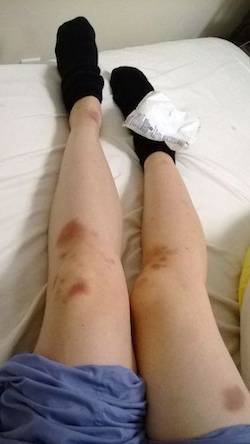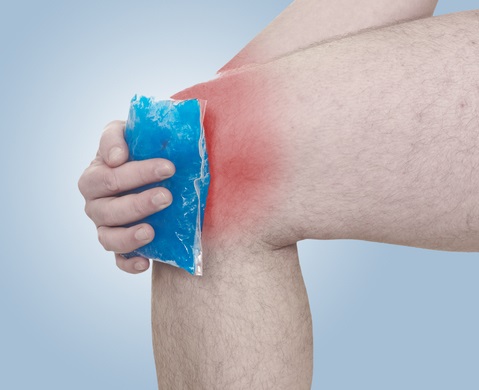By Leigh Schanfein of Dance Informa.
As devastating as a major injury can be, sometimes it’s the little things that get us down. When you’re always covered in bruises but have to keep doing that floor work, or you’ve ripped the same hole in your foot twice a day for the past month, you start to get desperate for a cure.
So, what are some things we can do about these nasty little injuries? A bevy of dancers shared their thoughts, and expert clinician Alan Kroll, MS, ATC, athletic trainer for many of Broadway’s major shows including Crazy for You, Steel Pier, The Color Purple, La Cage aux Folles, Follies and Jesus Christ Superstar, weighs in with his own special recommendations.
Cuts and split skin
To prevent: A lot of dancers like to use a fat-based balm to keep their skin softer so it’s less likely to split in the first place. This might be coconut oil, Bag Balm or a neutral lip balm. If your calluses start to get craggy, use a pumice stone to reduce thickness or nail clippers to trim tough edges so they don’t get caught and pull the wound open. Some dancers also develop elaborate taping methods, using flexible tape like Elastoplast to weave between the toes for strategic prevention.
To heal: Glue it shut! Almost every dancer I’ve asked responds with Super Glue to close up small cuts on their feet. Make sure the cut is clean and sterile and skin is trimmed, then do as the ER doctor might and use super glue to bring the edges of the skin together. Again, strategic taping can help keep a cut from opening further and keep it covered while it heals. One dancer and choreographer who shall remain nameless even recommended urinating on your open wounds to make them heal faster – but we really don’t need to go that far, and I wouldn’t recommend it – ewww!
Pro tips from Alan Kroll: Cuts need to be kept clean and sterile, preventing microorganisms from growing. This can be done with an alcohol swab or an antiseptic like Hibiclens. Bacitracin with zinc is an antibiotic cream that will help heal cuts faster. Leukotape is great for holding skin together as it is a strong adhesive and can stay on for a few days! Just be careful taking it off as it can tear skin too (nail polish remover works well as a dehesive.)

My poor legs in mid-February after performances with a lot of floor work.
Blisters
To prevent: Blisters form due to friction on the outer layers of skin. Placing a layer between what rubs and your skin can eliminate that friction. This could be tights, clothing or tape in many cases. Your skin will also toughen up with exposure so you will be less susceptible to blisters once your skin gets used to a new shoe or to dancing barefoot. If a blister is raw for a prolonged period or getting worse, then you need to remove the irritant to let it heal.
To heal: As with calluses, dancers can use a balm or oil to make sure their skin stays soft and doesn’t dry out and harden around the blister. Some dancers like using New-Skin to protect an open blister, while others will just wrap it in waterproof tape that won’t slide around during dance. Keep an open blister clean, sterile and covered.
Pro tips from Alan Kroll: If the blister is still intact, don’t pop it. If it has popped, leave the skin over the wound. If you need to pop it, use a sterile needle to make a small hole at the bottom and let the fluid drain out. Again, sterilize and cover an open or popped blister. Place a soft doughnut around the blister in addition to New-Skin or a Silipos (gel pad) protection. Simple Dr. Scholl’s callus pads work well as does moleskin, which can be cut to size and also used for cuts and splits. Lots of companies make “blister kits” that you can buy at the drug store.
Bruises
To prevent: Bruises occur when capillaries, the smallest blood vessels, and sometimes tiny veins are broken due to impact, allowing blood to pool near the surface of the skin. The fun purple, blue, brown and yellow colors you see are from your blood! Other than wearing padding, there is not much to prevent bruising except trying your best to control descents to the floor with strong muscles and smooth, coordinated movement, and trying not to run into things! Have we mentioned dancers are clumsy? (See this fun article: Why are dancers so clumsy?)
To heal: Use balms like Traumeel and Topricin, or Biofreeze and other arnica creams.
Pro tips from Alan Kroll: Don’t use a warming balm like Tiger Balm – it’s going to have the opposite effect and bring more blood to the area! Something like Traumeel is great because research has demonstrated that it has the similar anti-inflammatory and healing effects of NSAIDs (like aspirin, ibuprofen and naproxen), but without the negative soft tissue side effects.
Don’t let these little troubles get to you! You can easily take care of them so they don’t become persistent problems. Prevention is best, but sometimes that is a more difficult thing to do with a small injury like a bruise or a floor burn which, by the way, you should sterilize and keep clean and covered!
So use the tools of the trade to help you get on the mend quickly. Use all creams, especially antibacterial and antiseptics, as directed, and get creative with experimenting and practicing with your taping and padding techniques. Find something that works for you! Just remember, if anything is causing you persistent or intolerable pain, or looks infected, go see a trusted medical professional.
Alan Kroll, MS, ATC, is the owner of SportCare, and provides injury care and fitness training for performance enhancement to dancers, athletes, musicians and musical theatre performers in the New York City area.
This is merely an advice column. If you have questions or concerns about any of this information or your own cuts, blisters or bruises please speak to a medical professional. Dance Informa is not liable for the misuse of this information and encourages you to speak to a medical practitioner before using any of the techniques or products listed.















